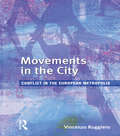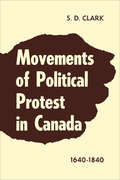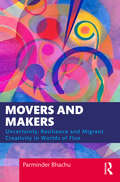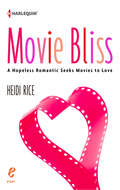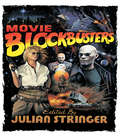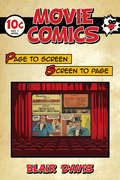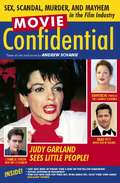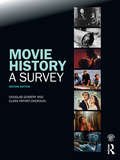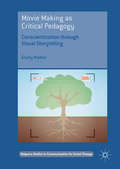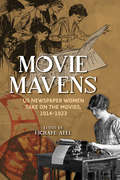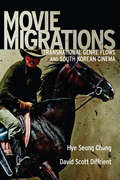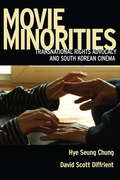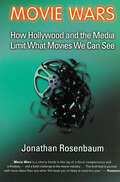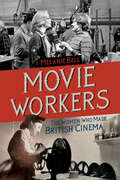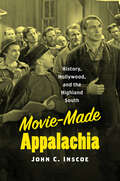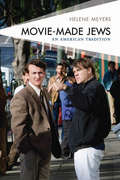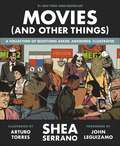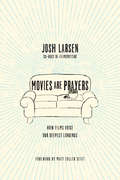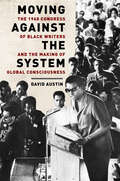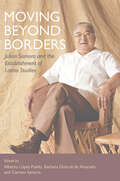- Table View
- List View
Movements in the City: Conflict in the European Metropolis
by Vincenzo RuggieroFor 2nd and 3rd year courses in urban sociology, sociology of exclusion, social stratification, planning and cultural studies in departments of sociology and urban geography. This book provides an in depth examination of social movements and urban life in European cities today. Unique in its interdisciplinary approach, it covers traditional areas of urban studies, sociological concerns about the concept of change and the characteristics of social movements. It presents current theory as well as discursive sections based around empirical work conducted in major European cities including London, Paris and Berlin.
Movements of Political Protest in Canada 1640-1840 (Social Credit in Alberta)
by S. D. ClarkIn this volume, Professor Clark shows that for two hundred years Canadian society was subject to the same kind of disturbing and disruptive forces that revealed themselves in the United States in the Revolutionary period. In Canada, as in the United States, there was a frontier element which, economically, socially, and culturally, did not feel itself part of the established political order, and which periodically reacted against that order. In Canada, however, the spirit of the frontier regularly met defeat, and the author analyses the causes of this defeat in a thorough and illuminating manner, dealing in sequence with each area of conflict. The study is divided into four parts: The First American War of Independence, 1660--1760; The War of the United Colonies, 1765--1785; The Struggle for the West, 1785--1815; The Canadian Rebellions, 1815--1840.The author, an economist and sociologist, diverges sharply from the traditional historical interpretation of events in Canada from 1640 to 1840, which has been to emphasize the differences between the two countries rather than similarities. His realistic and penetrating study may prompt many to re-examine and re-assess the bases of their interpretations.
Movers and Makers: Uncertainty, Resilience and Migrant Creativity in Worlds of Flux
by Parminder BhachuWe live in times of extreme change. There could be no better time than now to interrogate the lives of new kinds of people, movers and makers, who navigate fragility and uncertainty to create with daring, often against great odds. Parminder Bhachu uses their dramatic life stories to uncover what makes for creativity and resilience in times of disequilibrium. What can be learnt from their creative moxie as innovators outside establishment powers? Why has their creative reach grown exponentially in our globally connected twenty-first century? How have their abilities to innovate been catalyzed without subscription to knowledge hierarchies and monopolies? These culturally dexterous movers who possess movement capital, advanced with every migration, have translated ancient maker and craft skills into transforming modern technology, science, design, architecture, and the arts. Generous, inclusive, and deeply collaborative, they are at the heart of open source sharing for collective intelligence, the common good, and the maker movement. They invigorate the economies they reside in greatly enhancing creative capacities and reach. Bhachu, herself a multiple-migrant maker, offers us a model for a hopeful way forward, bringing her unique ethnographic insights to illuminate what can be learnt about thriving in worlds of flux.
Movie Bliss: A Hopeless Romantic Seeks Movies to Love
by Heidi RiceThe Romance Lover's Guide to Movie Must-Sees. If you adore Sleepless in Seattle and Pride and Prejudice and The Avengers, then you want a movie guide aimed at women like you. Women who enjoy romances and more! You like both a good kiss and a good knockout and refuse to be categorized-but you wish someone like you would recommend movies.Which brings Harlequin author and professional movie critic Heidi Rice to the rescue. Whether it's nonstop action with a little heart 'n' soul, sweetly adorable cartoons, a classic black-and-white screwball comedy or that under-the-radar flick that you never knew you were missing, Heidi Rice will lead you through her must-sees and why you will also enjoy them. From Ryan Gosling's six-pack to that iconic orgasm sandwich delivered by Meg Ryan, right up to the double whammy of hotties in Prisoners (Gyllenhaal and Jackman)-there's a little something for everyone.And a little something for that teenager inside you who's ready to watch "nekkid" man-candy and spend two hours falling in love all over again....
Movie Blockbusters
by Julian StringerBig-budget, spectacular films designed to appeal to a mass audience: is this what - or all - blockbusters are? Movie Blockbusters brings together writings from key film scholars, including Douglas Gomery, Peter Kramer, Jon Lewis and Steve Neale, to address the work of notable blockbuster auteurs such as Steven Spielberg and James Cameron, discuss key movies such as Star Wars and Titanic, and consider the context in which blockbusters are produced and consumed, including what the rise of the blockbuster says about the Hollywood film industry, how blockbusters are marketed and exhibited, and who goes to see them. The book also considers the movie scene outside Hollywood, discussing blockbusters made in Bollywood, China, South Korea, New Zealand and Argentina
Movie Comics: Page to Screen/Screen to Page
by Blair DavisAs Christopher Nolan’s Batman films and releases from the Marvel Cinematic Universe have regularly topped the box office charts, fans and critics alike might assume that the “comic book movie” is a distinctly twenty-first-century form. Yet adaptations of comics have been an integral part of American cinema from its very inception, with comics characters regularly leaping from the page to the screen and cinematic icons spawning comics of their own. Movie Comics is the first book to study the long history of both comics-to-film and film-to-comics adaptations, covering everything from silent films starring Happy Hooligan to sound films and serials featuring Dick Tracy and Superman to comic books starring John Wayne, Gene Autry, Bob Hope, Abbott & Costello, Alan Ladd, and Dean Martin and Jerry Lewis. With a special focus on the Classical Hollywood era, Blair Davis investigates the factors that spurred this media convergence, as the film and comics industries joined forces to expand the reach of their various brands. While analyzing this production history, he also tracks the artistic coevolution of films and comics, considering the many formal elements that each medium adopted and adapted from the other. As it explores our abiding desire to experience the same characters and stories in multiple forms, Movie Comics gives readers a new appreciation for the unique qualities of the illustrated page and the cinematic moving image.
Movie Confidential
by Andrew SchanieTruth really is stranger than fiction - just look at the film industry. The product on the screen is no match for what goes on when the cameras stop rolling. Movie Confidential lays out the story-behind-the-story of Hollywood's most sordid true tales. Encompassing sex, scandal, murder, and mayhem, it dishes the dirt on stars of the past and present. From what really happened in Fatty Arbuckle's infamous room at the St. Francis Hotel to Eddie Murray's "I was just giving her a ride" defense, from PCP-laced chowder on the set of Titanic to Judy Garland's strange visions, to mysterious deaths, mistakes in filmmaking, and a multitude of other irresistible tales, this cheeky collection covers the gamut. Packed with photos and presented in the style of vintage scandal magazines from the 1950s, Movie Confidential is a compulsively readable look at filmdom's seamy underbelly.
Movie History: Second Edition
by Douglas Gomery Clara Pafort-OverduinCovering everything from Edison to Avatar, Gomery and Pafort-Overduin have written the clearest, best organized, and most user-friendly film history textbook on the market. It masterfully distills the major trends and movements of film history, so that the subject can be taught in one semester. And each chapter includes a compelling case study that highlights an important moment in movie history and, at the same time, subtly introduces a methodological approach. This book is a pleasure to read and to teach. Peter Decherney, University of Pennsylvania, USA In addition to providing a comprehensive overview of the development of film around the world, the book gives us examples of how to do film history, including organizing the details and discussing their implications.Hugh McCarney, Western Connecticut State University, USA Douglas Gomery and Clara Pafort-Overduin have created an outstanding textbook with an impressive breadth of content, covering over 100 years in the evolution of cinema. Movie History: A Survey is an engaging book that will reward readers with a contemporary perspective of the history of motion pictures and provide a solid foundation for the study of film. Matthew Hanson, Eastern Michigan University, USA How can we understand the history of film? Historical facts don’t answer the basic questions of film history. History, as this fascinating book shows, is more than the simple accumulation of film titles, facts and figures. This is a survey of over 100 years of cinema history, from its beginnings in 1895, to its current state in the twenty-first century. An accessible, introductory text, Movie History: A Survey looks at not only the major films, filmmakers, and cinema institutions throughout the years, but also extends to the production, distribution, exhibition, technology and reception of films. The textbook is divided chronologically into four sections, using the timeline of technological changes: Section One looks at the era of silent movies from 1895 to 1927; Section Two starts with the coming of sound and covers 1928 until 1950; Section Three runs from 1951 to 1975 and deals with the coming and development of television; and Section Four focuses on the coming of home video and the transition to digital, from 1975 to 2010. Key pedagogical features include: timelines in each section help students to situate the films within a broader historical context case study boxes with close-up analysis of specific film histories and a particular emphasis on film reception lavishly illustrated with over 450 color images to put faces to names, and to connect pictures to film titles margin notes add background information and clarity glossary for clear understanding of the key terms described references and further reading at the end of each chapter to enhance further study. A supporting website is available at www.routledge.com/textbooks/moviehistory, with lots of extra materials, useful for the classroom or independent study, including: additional case studies – new, in-depth and unique to the website international case studies – for the Netherlands in Dutch and English timeline - A movie history timeline charting key dates in the history of cinema from 1890 to the present day revision flash cards – ideal for getting to grips with key terms in film studies related resources – on the website you will find every link from the book for ease of use, plus access to additional online material students are also invited to submit their own movie history case studies - see website for details Written by two highly respected film scholars and experienced teachers, Movie History is the ideal textbook for students studying film history.
Movie Making as Critical Pedagogy: Conscientization Through Visual Storytelling (Palgrave Studies In Communication For Social Change)
by Grady WalkerCan the stories people tell influence the way they see the world? This book seeks to address that question through a study of the viability of movie making as a critical pedagogy activity. Positioned at the intersection of education and communication for social change, it explores the relationship between the generation of subjective knowledge through storytelling and analysis, and systemic change. Central to the book is a case study from Nepal. By using video as the action element and analytical material of coursework, youth participants generated a new critical awareness, engendered by themes arising from group discussion. Through the analysis of these themes participants initiated an emergence known as conscientization. Led by two critical educators, participants used the production, screening, and analysis of their own movies to propel the course, or praxis, forward. This book seeks to inform the practice of critical pedagogy both practically and theoretically, and also offers a contribution to the fields of participatory action-research and communication for social change.
Movie Mavens: US Newspaper Women Take On the Movies, 1914-1923 (Women & Film History International)
by Dorothy Day Janet Flanner Kitty Kelly Genevieve Harris Virginia Dale Grace Kingsley Charlotta Bass Louella O. Parsons Esther Hoffman The Film Girl" Mildred Joclyn Oma Moody Lawrence Mae Tinee Charlotte S. Kelly Marjorie Daw Virginia Tracy Rae McRae Harriette Underhill Alberta HartleyDuring the early era of cinema, moviegoers turned to women editors and writers for the latest on everyone's favorite stars, films, and filmmakers. Richard Abel returns these women to film history with an anthology of reviews, articles, and other works. Drawn from newspapers of the time, the selections show how columnists like Kitty Kelly, Mae Tinee, Louella Parsons, and Genevieve Harris wrote directly to female readers. They also profiled women working in jobs like scenario writer and film editor and noted the industry's willingness to hire women. Sharp wit and frank opinions entertained and informed a wide readership hungry for news about the movies but also about women on both sides of the camera. Abel supplements the texts with hard-to-find biographical information and provides context on the newspapers and silent-era movie industry as well as on the professionals and films highlighted by these writers. An invaluable collection of rare archival sources, Movie Mavens reveals women's essential contribution to the creation of American film culture.
Movie Migrations
by David Scott Diffrient Hye Seung ChungAs the two billion YouTube views for "Gangnam Style" would indicate, South Korean popular culture has begun to enjoy new prominence on the global stage. Yet, as this timely new study reveals, the nation's film industry has long been a hub for transnational exchange, producing movies that put a unique spin on familiar genres, while influencing world cinema from Hollywood to Bollywood. Movie Migrations is not only an introduction to one of the world's most vibrant national cinemas, but also a provocative call to reimagine the very concepts of "national cinemas" and "film genre." Challenging traditional critical assumptions that place Hollywood at the center of genre production, Hye Seung Chung and David Scott Diffrient bring South Korean cinema to the forefront of recent and ongoing debates about globalization and transnationalism. In each chapter they track a different way that South Korean filmmakers have adapted material from foreign sources, resulting in everything from the Manchurian Western to The Host's reinvention of the Godzilla mythos. Spanning a wide range of genres, the book introduces readers to classics from the 1950s and 1960s Golden Age of South Korean cinema, while offering fresh perspectives on recent favorites like Oldboy and Thirst. Perfect not only for fans of Korean film, but for anyone curious about media in an era of globalization, Movie Migrations will give readers a new appreciation for the creative act of cross-cultural adaptation.
Movie Minorities: Transnational Rights Advocacy and South Korean Cinema
by David Scott Diffrient Hye Seung ChungRights advocacy has become a prominent facet of South Korea’s increasingly transnational motion picture output, especially following the 1998 presidential inauguration of Kim Dae-jung, a former political prisoner and victim of human rights abuses who received the Nobel Peace Prize in 2000. Today it is not unusual to see a big-budget production about the pursuit of social justice or the protection of civil liberties contending for the top spot at the box office. With that cultural shift has come a diversification of film subjects, which range from undocumented workers’ rights to the sexual harassment experienced by women to high-school bullying to the struggles among people with disabilities to gain inclusion within a society that has transformed significantly since winning democratic freedoms three decades ago. Combining in-depth textual analyses of films such as Bleak Night, Okja, Planet of Snail, Repatriation, and Silenced with broader historical contextualization, Movie Minorities offers the first English-language study of South Korean cinema’s role in helping to galvanize activist social movements across several identity-based categories.
Movie Wars: How Hollywood and the Media Limit What Movies We Can See
by Jonathan RosenbaumIs the cinema, as writers from David Denby to Susan Sontag have claimed, really dead? Contrary to what we have been led to believe, films are better than ever--we just can't see the good ones. Movie Wars cogently explains how movies are packaged, distributed, and promoted, and how, at every stage of the process, the potential moviegoer is treated with contempt. Using examples ranging from the New York Times's coverage of the Cannes film festival to the anticommercial practices of Orson Welles, Movie Wars details the workings of the powerful forces that are in the process of ruining our precious cinematic culture and heritage, and the counterforces that have begun to fight back.
Movie Workers: The Women Who Made British Cinema (Women & Film History International #1)
by Melanie BellRolling the credits on six decades of women in film After the advent of sound, women in the British film industry formed an essential corps of below-the-line workers, laboring in positions from animation artist to negative cutter to costume designer. Melanie Bell maps the work of these women decade-by-decade, examining their far-ranging economic and creative contributions against the backdrop of the discrimination that constrained their careers. Her use of oral histories and trade union records presents a vivid counter-narrative to film history, one that focuses not only on women in a male-dominated business, but on the innumerable types of physical and emotional labor required to make a motion picture. Bell's feminist analysis looks at women's jobs in film at important historical junctures while situating the work in the context of changing expectations around women and gender roles. Illuminating and astute, Movie Workers is a first-of-its-kind examination of the unsung women whose invisible work brought British filmmaking to the screen.
Movie-Made Appalachia: History, Hollywood, and the Highland South
by John C. InscoeWhile Hollywood deserves its reputation for much-maligned portrayals of southern highlanders on screen, the film industry also deserves credit for a long-standing tradition of more serious and meaningful depictions of Appalachia's people. Surveying some two dozen films and the literary and historical sources from which they were adapted, John C. Inscoe argues that in the American imagination Appalachia has long represented far more than deprived and depraved hillbillies. Rather, the films he highlights serve as effective conduits into the region's past, some grounded firmly in documented realities and life stories, others only loosely so. In either case, they deserve more credit than they have received for creating sympathetic and often complex characters who interact within families, households, and communities amidst a wide array of historical contingencies. They provide credible and informative narratives that respect the specifics of the times and places in which they are set. Having used many of these movies as teaching tools in college classrooms, Inscoe demonstrates the cumulative effect of analyzing them in terms of shared themes and topics to convey far more generous insights into Appalachia and its history than one would have expected to emerge from southern California's "dream factory."
Movie-Made Jews: An American Tradition
by Helene MeyersMovie-Made Jews focuses on a rich, usable American Jewish cinematic tradition. This tradition includes fiction and documentary films that make Jews through antisemitism, Holocaust indirection, and discontent with assimilation. It prominently features the unapologetic assertion of Jewishness, queerness, and alliances across race and religion. Author Helene Meyers shows that as we go to our local theater, attend a Jewish film festival, play a DVD, watch streaming videos, Jewishness becomes part of the multicultural mosaic rather than collapsing into a generic whiteness or being represented as a life apart. This engagingly-written book demonstrates that a Jewish movie is neither just a movie nor for Jews only. With incisive analysis, Movie-Made Jews challenges the assumption that American Jewish cinema is a cinema of impoverishment and assimilation. While it’s a truism that Jews make movies, this book brings into focus the diverse ways movies make Jews.
Movies (And Other Things)
by Shea Serrano#1 New York Times bestselling author Shea Serrano is back, and his new book, Movies (And Other Things), combines the fury of a John Wick shootout, the sly brilliance of Regina George holding court at a cafeteria table, and the sheer power of a Denzel monologue, all into one. p.p1 {margin: 0.0px 0.0px 0.0px 0.0px; line-height: 18.0px; font: 14.7px Tahoma; color: #000000; -webkit-text-stroke: #000000; background-color: #ffffff} p.p2 {margin: 0.0px 0.0px 0.0px 0.0px; line-height: 18.0px; font: 14.7px Tahoma; color: #000000; -webkit-text-stroke: #000000; min-height: 18.0px} p.p3 {margin: 0.0px 0.0px 0.0px 0.0px; line-height: 17.0px; font: 14.7px Arial; color: #000000; -webkit-text-stroke: #000000} span.s1 {font-kerning: none} span.s2 {font-kerning: none; background-color: #ffffff} Movies (And Other Things) is a book about, quite frankly, movies (and other things). One of the chapters, for example, answers which race Kevin Costner was able to white savior the best, because did you know that he white saviors Mexicans in McFarland, USA, and white saviors Native Americans in Dances with Wolves, and white saviors Black people in Black or White, and white saviors the Cleveland Browns in Draft Day? Another of the chapters, for a second example, answers what other high school movie characters would be in Regina George's circle of friends if we opened up the Mean Girls universe to include other movies (Johnny Lawrence is temporarily in, Claire from The Breakfast Club is in, Ferris Bueller is out, Isis from Bring It On is out...). Another of the chapters, for a third example, creates a special version of the Academy Awards specifically for rom-coms, the most underrated movie genre of all. And another of the chapters, for a final example, is actually a triple chapter that serves as an NBA-style draft of the very best and most memorable moments in gangster movies. Many, many things happen in Movies (And Other Things), some of which funny, others of which are sad, a few of which are insightful, and all of which are handled with the type of care and dedication to the smallest details and pockets of pop culture that only a book by Shea Serrano can provide.
Movies Are Prayers: How Films Voice Our Deepest Longings
by Josh Larsen"Movies are our way of telling God what we think about this world and our place in it. . . . Movies can be many things: escapist experiences, historical artifacts, business ventures, and artistic expressions, to name a few. I'd like to suggest that they can also be prayers."Filmspotting
Movies under the Influence
by Jocelyn Szczepaniak-GilleceA cultural history of the enduring relationship between film spectatorship and intoxicating substances Movies under the Influence charts the entangled histories of moviegoing and mind-altering substances from early cinema through the psychedelic 1970s. Jocelyn Szczepaniak-Gillece examines how the parallel trajectories of these two enduring aspects of American culture, linked by their ability to influence individual and collective consciousness, resulted in them being treated and regulated in similar ways. Rather than looking at representations of drug use within film, she regards cinema and intoxicants as kindred experiences of immersion that have been subject to corresponding forces of ideology and power. Exploring the effects of intoxicants such as caffeine, nicotine, alcohol, marijuana, and psychedelics on film spectatorship, Szczepaniak-Gillece demonstrates how American movie theaters sought to cultivate a dual identity, presenting themselves as both a place of wholesome entertainment and a shadowy zone of illicit behavior. Movies under the Influence highlights the various legislative, legal, and corporate powers that held sway over the darkened anonymity of theaters, locating the convergence of moviegoing and drug use as a site of mediation and social control in America. As much as substances and cinema are points where power intervenes, they are also settings of potential transcendence, and Movies under the Influence maintains this paradox as a necessary component of American film history. Recontextualizing a wide range of films, from Hollywood to the avant-garde, this book examines the implicit relationship intoxicants suggest between mass media, spectatorship, and governmental regulation and provides a new angle from which to understand cinema&’s lasting role in evolving American culture.
Moving (Houghton Mifflin Vocabulary Reader Accompanies Journeys)
by Inés BallesterosNIMAC-sourced textbook <P><P>Level G DRA 12 Social Studies Strategy-Summarize
Moving Against the System: The 1968 Congress of Black Writers and the Making of Global Consciousness
by David AustinIn 1968, as protests shook France and war raged in Vietnam, the giants of Black radical politics descended on Montreal to discuss the unique challenges and struggles facing their brothers and sisters. For the first time since 1968, David Austin brings alive the speeches and debates of the most important international gathering of Black radicals of the era. Against a backdrop of widespread racism in the West, and colonialism and imperialism in the “Third World,” this group of activists, writers, and political figures gathered to discuss the history and struggles of people of African descent and the meaning of Black Power. With never-before-seen texts from Stokely Carmichael, Walter Rodney, and C.L.R. James, Moving Against the System will prove invaluable to anyone interested in Black radical thought, as well as capturing a crucial moment of the political activity around 1968.
Moving Beyond Borders
by Karen FlynnMoving Beyond Borders is the first book-length history of Black health care workers in Canada, delving into the experiences of thirty-five postwar-era nurses who were born in Canada or who immigrated from the Caribbean either through Britain or directly to Canada. Karen Flynn examines the shaping of these women's stories from their childhoods through to their roles as professionals and community activists.Flynn interweaves oral histories with archival sources to show how these women's lives were shaped by their experiences of migration, professional training, and family life. Theoretical analyses from postcolonial, gender, and diasporic Black Studies serve to highlight the multiple subjectivities operating within these women's lives. By presenting a collective biography of identity formation, Moving Beyond Borders reveals the extraordinary complexity of Black women's history.
Moving Beyond Borders: Julian Samora and the Establishment of Latino Studies (Latinos in Chicago and Midwest)
by Alberto Lopez PulidoMoving Beyond Borders examines the life and accomplishments of Julian Samora, the first Mexican American sociologist in the United States and the founding father of the discipline of Latino studies. Detailing his distinguished career at the University of Notre Dame from 1959 to 1984, the book documents the history of the Mexican American Graduate Studies program that Samora established at Notre Dame and traces his influence on the evolution of border studies, Chicano studies, and Mexican American studies. Samora's groundbreaking ideas opened the way for Latinos to understand and study themselves intellectually and politically, to analyze the complex relationships between Mexicans and Mexican Americans, to study Mexican immigration, and to ready the United States for the reality of Latinos as the fastest growing minority in the nation. In addition to his scholarly and pedagogical impact, his leadership in the struggle for civil rights was a testament to the power of community action and perseverance. Focusing on Samora's teaching, mentoring, research, and institution-building strategies, Moving Beyond Borders explores the legacies, challenges, and future of ethnic studies in United States higher education. Contributors are Teresita E. Aguilar, Jorge A. Bustamante, Gilberto Cárdenas, Miguel A. Carranza, Frank M. Castillo, Anthony J. Cortese, Lydia Espinosa Crafton, Barbara Driscoll de Alvarado, Herman Gallegos, Phillip Gallegos, José R. Hinojosa, Delfina Landeros, Paul López, Sergio X. Madrigal, Ken Martínez, Vilma Martínez, Alberto Mata, Amelia M. Muñoz, Richard A. Navarro, Jesus "Chuy" Negrete, Alberto López Pulido, Julie Leininger Pycior, Olga Villa Parra, Ricardo Parra, Victor Rios, Marcos Ronquillo, Rene Rosenbaum, Carmen Samora, Rudy Sandoval, Alfredo Rodriguez Santos, and Ciro Sepulveda.
Moving Beyond Words
by Gloria SteinemFrom one of the most influential women in the country and bestselling author of "Revolution from Within" comes a collection of provocative, entertaining, mind-changing essays.
Moving Beyond Words: Essays on Age, Rage, Sex, Power, Money, Muscles: Breaking the Boundaries of Gender
by Gloria SteinemEssays from the New York Times–bestselling author who inspired the film The Glorias, a &“woman who has told the truth about her life and ours&” (Los Angeles Times). With cool humor and rich intellect, Gloria Steinem strips bare our social constructions of gender and race, explaining just how limiting these invented cultural identities can be. In the first of six sections, Steinem imagines how our understanding of human psychology would be different in a witty reversal: What if Freud had been a woman who inflicted biological inferiority on men (think &“womb envy&”)? In other essays, she presents positive examples of people who turn gendered stereotypes on their heads, from a female bodybuilder to Mahatma Gandhi, whose followers absorbed his wisdom that change starts at the bottom. And in some of the most moving pieces, Steinem reveals some of her own complicated history as a writer, woman, and citizen of the world. This ebook features an illustrated biography of Gloria Steinem including rare images from the author&’s personal collection.
